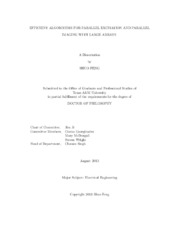| dc.description.abstract | During the past two decades, techniques and devices were developed to transmit and receive signals with a phased array instead of a single coil in the MRI (Magnetic Resonance Imaging) system. The two techniques to simultaneously transmit and receive RF signals using phased arrays are called parallel excitation (pTx) and parallel imaging (PI), respectively. These two techniques lead to shorter transmit pulses for higher imaging quality and faster data acquisition correspondingly.
This dissertation focuses on improving the efficiency of the pTx pulse design and the PI reconstruction in MRI. Both PI and pTx benefit from the increased number of elements of the array. However, efficiency concerns may arise which include: (1) In PI, the computation cost of the reconstructions and the achievable acceleration factors and (2) in pTx, the pulse design speed and memory cost. The work presented in this dissertation addresses these issues.
First, a correlation based channel reduction algorithm is developed to reduce the computation cost of PI reconstruction. In conventional k-domain methods, the individual channel data is reconstructed via linear interpolation of the neighbourhood data from all channels. In this proposed algorithm, we choose only a subset of the channels based on the spatial correlation. The results have shown that the computation cost can be significantly reduced with similar or higher reconstruction accuracy.
Then, a new parallel imaging method named parallel imaging using localized receive arrays with Sinc interpolation(PILARS) is proposed to improve the actual acceleration factor and to reduce the computation cost. It employs the local support of individual coils and pre-determines the magnitude of the reconstruction coefficients. Thus, it requires much less auto-calibration signals (ACS) data and achieves higher acceleration factors. The results show that this method can increase the acceleration factor and the reconstruction speed while achieving the same level of reconstruction quality.
Finally, a fast pTx pulse design method is proposed to accelerate the design speed. This method is based on the spatial domain pulse design method and can be used to accelerate similar methods. We substitute the two computational expensive matrix- vector multiplications in the conjugate gradient (CG) solver with gridding and fast Fourier transform (FFT). Theoretical and simulation results have shown that the design speed can be improved by 10 times. Meanwhile, the memory cost is reduced by 103 times. This breaks the memory burden of implementing pulse designs on GPU which enables further accelerations. | en |


